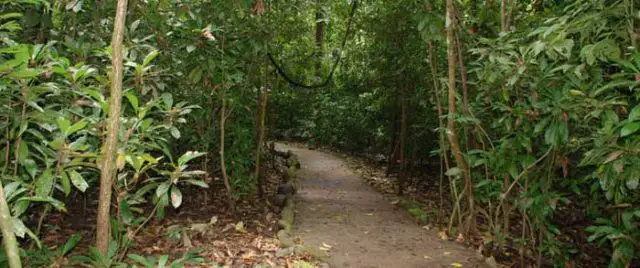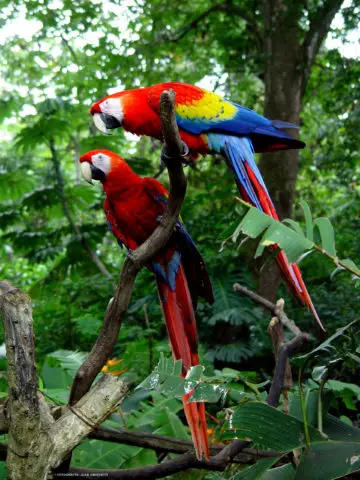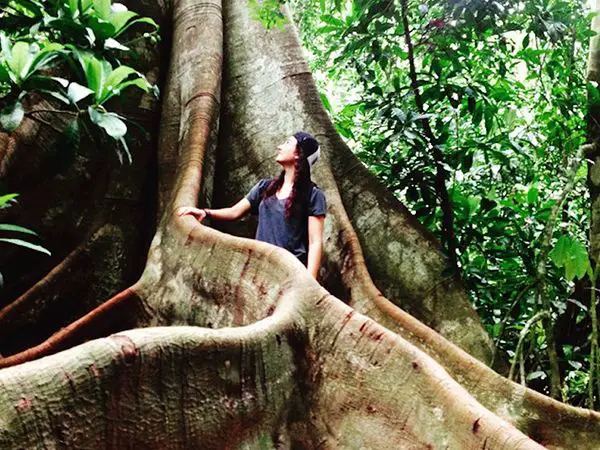
Carara is located in the transitional zone between the dry and wet forests of the Pacific region. Considered as an excellent living laboratory, where you can study the structure and functioning of tropical ecosystems and the relationships between them, it also has numerous vestiges of pre-Columbian indigenous occupations.
This National Park is a world-famous ornithological destination since it has very diverse bird species, where the Red Lapa (Ara Macao) stands out, a species that is in danger of extinction, being the second largest species of Psittacids in Costa Rica.
“Carara” is a word from the native Huetar language that means “river of lizards”, and is the name given by the indigenous huetares to the Rio Grande de Tárcoles before the arrival of the Spaniards in Costa Rica. It is located about 90 kilometers west of the Costa Rican capital of San José, following the southern coastal road between the banks of the Grande de Tárcoles River and travel time from San José is approximately one hour, and about 15 kilometers north of the beach in the city of Jaco.
History
What is known today as Carara National Park was part of a large agricultural estate called Hacienda Coyolar, one of the largest privately-owned land concentrations the country has had, which extended from Orotina to Parrita, with a territory of thousands of hectares belonging to Dr. Fernando Castro Cervantes, who years later sold them to the Agrarian Development Institute (IDA), an institution that transferred these lands to the National Park Service (SPN)?
The protected area was created on April 27, 1978, as a category of biological reserve management and emerged in response to national and regional natural resource conservation needs. Due to the influx of numerous visitors since 1990, the category is modified to become a National Park in November 1998.
Amazing Flora and Fauna

With 5,242 hectares, Carara National Park has an amazing diversity of flora and fauna, which makes it a must-see place if you are in the area. Monkeys, crocodiles, armadillos, peccaries, water birds, opossums, sloths, boas, margay felines, jaguars, white-tailed deer, and ozelotes can be found here, as well as a variety of birds and other reptiles and amphibians.
With one of the largest tree diversities in the world, this national park has 10 of the rarest and most unusual wood species in the country. The huge trees here are covered by vines and epiphytes. However, since there is very little foliage the animals and birds in this national park are easier to detect. A great place to get a fantastic view of the park is from the Río Tárcoles Bridge, where you can watch the crocodiles or take a look at the scarlet macaws that fly over the area always in groups.
Carara has ecosystems such as marshes, a lagoon, secondary and primary forests. The marshes are formed by the seasonal floods. The lagoon occupies an extensive abandoned meander of the Río Grande de Tárcoles, measuring about 600 meters long, 40 meters wide and 2 meters deep. Virtually everything is covered with choreja or water lily and other aquatic plants.
In this environment, there are many species of reptiles such as crocodiles that measure up to three meters long and water birds such as pink herons, needle ducks, water cocks, piquipintos divers and martín peña.
Archeology
The Carara National Park has fifteen pre-Columbian archeological sites, belonging to the archaeological area of the Central Region of Costa Rica, corresponding to two periods of occupation: Pavas Phase (300 BC to 300 AD) and Cartago Phase (800 to 1500 AD).
The site of Carara, which corresponds to the Carthage Phase, stands out and is characterized by the presence of a rectangular 6 x 4-meter site. It is built with calcareous rocks and river stones. Another important site in Lomas Entierro, which is an extensive village of residential and funeral areas, located on a hill in front of the Río Grande de Tárcoles. It is believed that this village exercised political and economic dominance over the inhabitants in the lower area of this river.
Tourism.

In addition to the impressive scenic beauty of the practically virgin and regenerated tropical forest that reaches the sea, being a lush biological corridor of great biodiversity, it is especially attractive for birdwatchers for its great diversity and internal paths accessibility and the presence of diverse lodging offers and varied touristic services in the vicinities of the park.
An ambitious project is currently underway to implement an exemplary model of a “Master Broad-Spectrum Nature Trails Plan”, as well as a new Visitor Center and a crocodile viewpoint adjacent to the Río Grande de Tárcoles, taking advantage of the accommodation availability in and around the bridge over the coastal route and which have been rated as the most photographed in the world, since it is an almost mandatory stop for more than one million tourists a year. These projects have been designed by the renowned architects and environmentalists Ibo Bonilla and Rafael Víquez as part of a strategic and solidary alliance between SINAC, PROPARQUES, VALDESOL, TELETICA, ICE, and several private companies.

